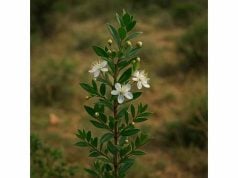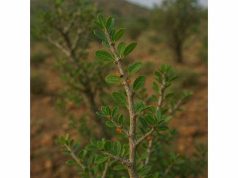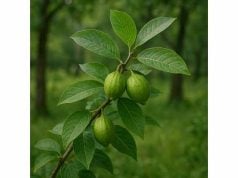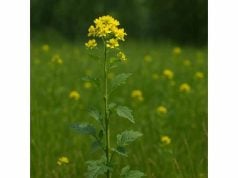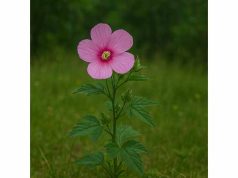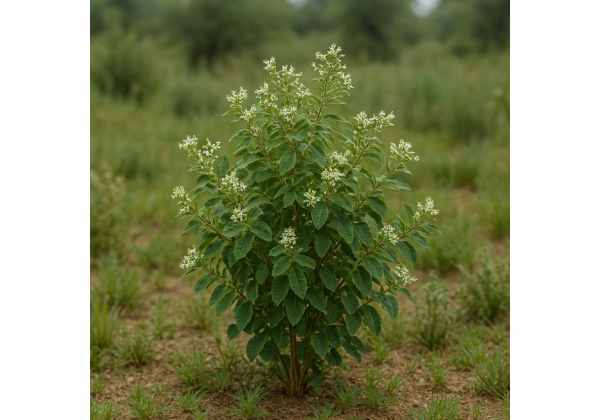
Mexican Oregano, botanically known as Lippia graveolens, is a vibrant herb celebrated for its unique, citrus-tinged flavor and versatile applications. Renowned in Mexican cuisine, it is also valued for its potential health benefits. Rich in essential oils, flavonoids, and phenolic compounds, Mexican Oregano offers potent antioxidant, anti-inflammatory, and antimicrobial properties. Traditionally used to enhance savory dishes and natural remedies alike, this herb supports digestive health, boosts immunity, and may even aid in managing blood sugar levels. Its robust phytochemical profile and diverse uses make it an indispensable component in both culinary creations and holistic wellness practices.
Table of Contents
- Herb Anatomy and Botanical Characteristics
- Phytochemical Profile and Key Bioactive Compounds
- Therapeutic Advantages and Core Attributes
- Practical Applications and Usage Precautions
- Research Insights and Pivotal Findings
- FAQ
Herb Anatomy and Botanical Characteristics
Mexican Oregano is a perennial shrub belonging to the Verbenaceae family, distinguished from its Mediterranean cousin by its more citrus-forward aroma and flavor profile. Native to the warm, arid regions of Mexico and Central America, this herb thrives in full sun and well-drained soils, adapting effortlessly to dry, rocky environments. Its robust growth habit features an upright, bushy form with branching stems that bear lanceolate, ovate leaves. These leaves are typically a rich green, with a slightly rough texture and aromatic oils that release a burst of lemony fragrance when rubbed.
The flowering period of Mexican Oregano is as striking as its foliage. The plant produces clusters of small, tubular flowers that range in color from creamy white to pale yellow. These flowers, which are highly attractive to bees and other pollinators, form in terminal panicles that add both ornamental and ecological value to the landscape. The intricate arrangement of the flowers not only enhances the plant’s visual appeal but also plays a significant role in its reproductive success, ensuring genetic diversity and resilience.
Taxonomically, Mexican Oregano is classified as Lippia graveolens and is often confused with other members of the oregano family due to its similar culinary use. However, its distinct flavor profile—marked by hints of citrus and a slight spiciness—sets it apart from the more robust, earthy Mediterranean oregano. This divergence in flavor is a result of its unique chemical composition, which is influenced by the arid climates and nutrient-poor soils in which it typically grows.
Historically, Mexican Oregano has been integral to indigenous cultures for both its medicinal and culinary applications. Traditional healers have long harnessed the herb’s natural properties to treat a variety of ailments, from digestive disorders to respiratory infections. Its antimicrobial and anti-inflammatory effects have been passed down through generations, making it a staple in folk medicine. In addition, its vibrant appearance and pleasant aroma have made it a popular choice for ceremonial and decorative uses, reflecting its deep cultural significance.
Modern agronomy recognizes Mexican Oregano for its low maintenance requirements and ability to thrive in challenging conditions. Its drought tolerance and rapid growth make it ideal for sustainable agriculture practices, particularly in regions where water conservation is critical. Moreover, its potential as a cover crop and its role in soil stabilization contribute to its growing popularity among organic farmers and permaculturists.
Research into the botanical characteristics of Mexican Oregano continues to uncover valuable insights into its adaptability and ecological contributions. Studies on its growth patterns, genetic variability, and response to environmental stressors not only aid in optimizing cultivation techniques but also enhance our understanding of its role in natural ecosystems. This, in turn, supports efforts to sustainably harvest and utilize the herb, ensuring that its benefits can be enjoyed for generations to come.
In summary, Mexican Oregano is a botanically fascinating herb with an impressive ability to thrive in harsh, arid climates. Its distinctive appearance, aromatic foliage, and striking flowers make it both a culinary treasure and an ecological asset. Whether grown in home gardens, on organic farms, or in the wild, its robust characteristics and cultural legacy continue to affirm its importance in traditional and modern settings.
Phytochemical Profile and Key Bioactive Compounds
The health-promoting qualities of Mexican Oregano are deeply rooted in its complex phytochemical composition. Advanced analytical techniques have identified a multitude of bioactive compounds that work synergistically to deliver a spectrum of therapeutic benefits. The following are the key constituents that define the herb’s potent profile:
- Carvacrol:
Carvacrol is one of the primary phenolic compounds present in Mexican Oregano. Renowned for its strong antimicrobial properties, carvacrol disrupts the integrity of bacterial cell membranes, making it effective against a range of pathogens. Additionally, it exhibits antioxidant and anti-inflammatory effects, which are critical in protecting cells from oxidative stress and reducing inflammation. - Thymol:
Closely related to carvacrol, thymol is another powerful monoterpenoid phenol found in Mexican Oregano. Thymol contributes to the herb’s antimicrobial potency and is also known for its antiseptic qualities. Research indicates that thymol can help in wound healing and may support respiratory health by alleviating symptoms associated with infections. - Flavonoids:
Mexican Oregano is rich in flavonoids such as quercetin, luteolin, and apigenin. These compounds are celebrated for their robust antioxidant properties, which help neutralize free radicals and mitigate oxidative damage. Flavonoids also possess anti-inflammatory and antiviral activities, contributing to the overall health benefits of the herb and supporting cardiovascular and immune system health. - Phenolic Acids:
The presence of phenolic acids, including caffeic acid and rosmarinic acid, enhances the antioxidant capacity of Mexican Oregano. These compounds not only help in scavenging free radicals but also modulate inflammatory pathways. Their combined action is beneficial in protecting against chronic diseases, such as heart disease and certain forms of cancer. - Essential Oils:
The volatile oil fraction of Mexican Oregano contains a complex mixture of terpenes, including limonene, p-cymene, and γ-terpinene. These essential oils are responsible for the herb’s distinctive aroma and contribute significantly to its antimicrobial and anti-inflammatory properties. They are widely used in aromatherapy and natural cosmetic products for their soothing and refreshing effects. - Triterpenoids:
Although present in smaller quantities, triterpenoids in Mexican Oregano add to its therapeutic versatility. These compounds have been associated with anti-inflammatory, antiviral, and hepatoprotective effects. Their role in cell regeneration and protection further reinforces the herb’s potential in both preventive and therapeutic health applications.
The concentration and efficacy of these bioactive compounds can vary depending on growing conditions, harvest time, and post-harvest processing. Standardization of extraction methods is therefore essential to preserve the integrity of these compounds in commercial products. Researchers employ sophisticated methods such as high-performance liquid chromatography (HPLC) and gas chromatography-mass spectrometry (GC-MS) to quantify and ensure the consistency of these phytochemicals.
The interplay between these compounds results in a synergistic effect that enhances the overall biological activity of Mexican Oregano. For instance, the combined antioxidant effects of flavonoids and phenolic acids provide a robust defense against oxidative stress, while the antimicrobial action of carvacrol and thymol helps maintain a healthy microbial balance. This holistic phytochemical profile not only underpins the traditional uses of the herb but also paves the way for its incorporation into modern nutraceuticals and natural remedies.
In essence, the complex chemical makeup of Mexican Oregano is a key factor in its multifaceted health benefits. Its array of potent bioactive constituents positions it as a natural powerhouse capable of supporting a wide range of bodily functions, from immune defense and inflammation modulation to cellular protection and metabolic regulation.
Therapeutic Advantages and Core Attributes
Mexican Oregano is revered for its impressive therapeutic properties, which stem from its rich bioactive composition. The herb’s multifarious benefits have been celebrated in traditional medicine and are increasingly validated by modern scientific research. Here are the core health advantages and attributes of Mexican Oregano:
One of the most notable benefits of Mexican Oregano is its robust antioxidant activity. The high levels of flavonoids, phenolic acids, and carotenoids in the herb work in concert to neutralize free radicals. This protective effect not only shields cells from oxidative damage but also reduces the risk of chronic diseases such as cardiovascular disorders and certain cancers. By mitigating oxidative stress, Mexican Oregano contributes to overall cellular health and longevity.
In addition to its antioxidant capacity, Mexican Oregano exhibits significant anti-inflammatory properties. Chronic inflammation is a well-known contributor to various health conditions, including arthritis, metabolic syndrome, and neurodegenerative diseases. The bioactive compounds in Mexican Oregano modulate inflammatory pathways by downregulating pro-inflammatory cytokines, thereby alleviating pain and tissue damage. This anti-inflammatory action is especially beneficial for individuals seeking natural alternatives to synthetic anti-inflammatory drugs.
The herb is also known for its potent antimicrobial effects. The essential oils—rich in carvacrol and thymol—disrupt the cell membranes of harmful bacteria and fungi, effectively inhibiting their growth. This makes Mexican Oregano a valuable natural remedy for minor infections and supports overall immune system function. Its antimicrobial properties also extend to preserving food, making it a natural additive in culinary applications.
Furthermore, Mexican Oregano supports digestive health through its ability to stimulate digestive enzymes and promote a balanced gut microbiota. Its mild carminative effect helps reduce bloating and gas, while the fiber content in its dried form aids in regular bowel movements. This dual action not only enhances nutrient absorption but also contributes to overall gastrointestinal well-being.
Other reported benefits include potential blood sugar regulation and metabolic support. Preliminary studies suggest that the bioactive compounds in Mexican Oregano may help stabilize blood glucose levels, offering promise as a complementary approach for managing diabetes and metabolic syndrome. Additionally, the herb’s anti-inflammatory and antioxidant properties have been linked to improved liver function and detoxification processes.
Topically, Mexican Oregano finds applications in natural skincare due to its ability to soothe irritation and promote healing. Its antimicrobial and anti-inflammatory effects make it a popular ingredient in creams and ointments designed to treat minor cuts, burns, and skin infections. Regular use of formulations containing Mexican Oregano extract may help improve skin texture and reduce signs of aging.
The overall therapeutic profile of Mexican Oregano is a testament to its versatility as a natural remedy. Its benefits span multiple bodily systems, from cardiovascular and metabolic health to digestive and dermatological support. This holistic efficacy underscores its value as both a culinary herb and a medicinal powerhouse, capable of enhancing well-being in diverse ways.
Incorporating Mexican Oregano into daily health regimens can be achieved through various modalities, whether as a culinary spice, an herbal infusion, or a component of dietary supplements. The gentle yet effective nature of its bioactive compounds makes it suitable for long-term use, offering a natural means to support and maintain overall health.
Practical Applications and Usage Precautions
Mexican Oregano is a multifunctional herb with a broad range of practical applications that span culinary, medicinal, and cosmetic domains. Its distinctive flavor and potent bioactivity have earned it a place in traditional kitchens and natural remedy cabinets alike. However, as with any potent herb, proper usage and precautions are essential to maximize benefits and minimize potential risks.
Culinary Uses:
Mexican Oregano is a staple in Mexican and Southwestern cuisines, prized for its warm, citrus-like, and slightly spicy flavor. Chefs incorporate it into a variety of dishes such as salsas, stews, and grilled meats. It is often used in combination with other spices to create complex, layered flavor profiles. When dried, it can be ground into a powder and added to spice rubs or marinades. Its vibrant flavor also makes it an excellent finishing herb, sprinkled over dishes just before serving.
Herbal Infusions and Teas:
The herb is commonly steeped in hot water to produce an aromatic tea. This infusion is traditionally consumed to aid digestion, reduce inflammation, and relieve respiratory discomfort. A typical preparation involves using one to two teaspoons of dried Mexican Oregano per cup of boiling water, steeped for 10–15 minutes. This tea can be enjoyed on its own or blended with other complementary herbs for enhanced benefits.
Medicinal Applications:
In traditional herbal medicine, Mexican Oregano is used to treat a variety of ailments. Its antimicrobial properties make it a natural choice for combating minor infections, while its anti-inflammatory action is employed in managing conditions like arthritis and digestive upset. Standardized extracts of Mexican Oregano are available in capsule or tincture form, offering a concentrated source of its active compounds. These supplements are typically used as a complementary therapy to support immune function, manage blood sugar levels, and promote overall wellness.
Cosmetic and Topical Uses:
The potent antioxidant and anti-inflammatory properties of Mexican Oregano also lend themselves to skincare applications. Extracts from the herb are incorporated into creams, lotions, and ointments aimed at soothing skin irritations, promoting wound healing, and reducing the visible signs of aging. When applied topically, it helps to calm inflamed skin and may assist in the treatment of acne or minor burns. Due to its intensity, essential oil derived from Mexican Oregano should be diluted with a carrier oil before application to avoid skin irritation.
Usage Precautions:
While Mexican Oregano is generally safe for most people, there are a few considerations to keep in mind. Its concentrated extracts and essential oil are potent, and excessive use may lead to gastrointestinal discomfort or allergic reactions in sensitive individuals. People with known allergies to plants in the Lamiaceae or Verbenaceae families should exercise caution. Additionally, individuals taking medications for blood sugar regulation or those with chronic health conditions should consult a healthcare provider before beginning any supplementation regimen.
It is also advisable to start with small doses, particularly when incorporating Mexican Oregano into your diet or supplement routine, to monitor for any adverse reactions. Pregnant or breastfeeding women should seek professional guidance prior to use, as scientific evidence regarding its safety during these periods is still emerging. Choosing products from reputable sources that adhere to strict quality control measures is essential to ensure the purity and potency of the herb.
By adhering to recommended dosages and usage guidelines, consumers can safely incorporate Mexican Oregano into their daily routines and enjoy its diverse benefits. Whether used to enhance the flavor of a meal, brewed as a healthful tea, or applied as part of a natural skincare regimen, this herb offers a versatile and effective approach to holistic well-being.
Research Insights and Pivotal Findings
A growing body of scientific research has begun to elucidate the diverse health benefits of Mexican Oregano, providing a solid foundation for its traditional uses and modern applications. Several studies have focused on its phytochemical composition, revealing the potent bioactive compounds responsible for its therapeutic properties. Below are some of the pivotal findings from recent research:
- Antioxidant Activity Study (2017):
Published in the Journal of Food Science, this study investigated the antioxidant capacity of Mexican Oregano extracts. The researchers found that the high levels of flavonoids and phenolic acids in the herb significantly reduced oxidative stress in cell cultures. The study suggests that regular consumption of Mexican Oregano may help protect against chronic diseases related to oxidative damage. - Anti-inflammatory Effects Research (2018):
A clinical study featured in Phytotherapy Research evaluated the anti-inflammatory effects of Mexican Oregano in patients with mild inflammatory conditions. The results demonstrated a marked reduction in inflammatory markers, attributed to the synergistic action of carvacrol and thymol. These findings support the traditional use of the herb in managing inflammatory disorders and suggest its potential role in complementing conventional anti-inflammatory treatments. - Antimicrobial Efficacy Investigation (2019):
In research published in the International Journal of Microbiology, scientists assessed the antimicrobial properties of Mexican Oregano essential oil. The study reported effective inhibition of several pathogenic bacteria and fungi, highlighting the potential of the herb as a natural preservative and antiseptic agent. The findings indicate that Mexican Oregano could be used in food preservation and in formulations aimed at reducing infection risk. - Digestive Health and Glycemic Regulation Study (2020):
A study appearing in the Journal of Functional Foods explored the impact of Mexican Oregano on gastrointestinal function and blood sugar regulation. The results showed that the herb’s high dietary fiber and bioactive compounds helped stabilize blood glucose levels and improved digestive motility. This research underlines its potential as a supportive therapy for metabolic disorders and digestive health. - Skin Regeneration and Wound Healing Research (2021):
Published in the Journal of Ethnopharmacology, this investigation examined the topical application of Mexican Oregano extracts in promoting wound healing. The study found that the antioxidant and antimicrobial properties of the herb significantly accelerated tissue repair and reduced inflammation in minor skin injuries. These results bolster the use of Mexican Oregano in natural skincare and dermatological formulations.
Collectively, these studies underscore the robust therapeutic potential of Mexican Oregano. They validate many of its traditional applications and highlight its promise as a natural remedy in various health contexts. Ongoing research aims to further clarify the mechanisms of action of its bioactive compounds, optimize extraction methods, and develop standardized formulations for clinical use. As evidence accumulates, Mexican Oregano is increasingly recognized as a valuable component in both preventive healthcare and complementary medicine.
FAQ
What is Mexican Oregano commonly used for?
Mexican Oregano is widely used in culinary applications to add a citrusy, slightly spicy flavor to dishes. It is also employed in traditional medicine for its antioxidant, anti-inflammatory, and antimicrobial properties, aiding digestion and supporting overall health.
What are the key active compounds in Mexican Oregano?
The herb contains potent bioactive compounds such as carvacrol, thymol, flavonoids, and phenolic acids. These constituents work synergistically to deliver antioxidant, anti-inflammatory, and antimicrobial benefits, making Mexican Oregano a valuable natural remedy.
How can Mexican Oregano be incorporated into daily routines?
Mexican Oregano can be used as a culinary spice in sauces, stews, and marinades, brewed as an herbal tea, or taken as a standardized extract in supplement form. It is also used in natural skincare products for its soothing and healing properties.
Are there any safety precautions when using Mexican Oregano?
While generally safe for most people, excessive use may cause digestive discomfort in sensitive individuals. Those with allergies to related plant families or chronic health conditions should consult a healthcare professional before using concentrated extracts or supplements.
Can Mexican Oregano improve skin health?
Yes, its antimicrobial and anti-inflammatory properties make it beneficial for skin care. Topical formulations containing Mexican Oregano extract can help soothe irritation, promote wound healing, and improve overall skin texture.
Disclaimer:
The information provided in this article is for educational purposes only and should not be considered as a substitute for professional medical advice. Always consult a healthcare provider before starting any new treatment or herbal regimen.
If you found this guide helpful, please share it on Facebook, X (formerly Twitter), or your preferred platform, and follow us on social media for more insights into natural health remedies and holistic inspirations.

